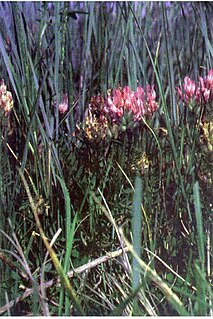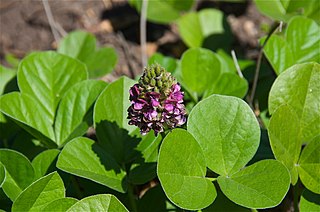
Genista canariensis is a species of flowering plant in the legume family Fabaceae, known by the common names Canary broom, Canary Islands broom or florist's genista. It is native to the Canary Islands, but it grows as an introduced species in mainland Europe, especially Spain, and on other continents. It has been introduced to California and Washington State in the US. This is a vigorous upright evergreen shrub growing to 3 m (9.8 ft) tall by 1.5 m (4.9 ft) broad, with hairy green stems. The leaves are made up of oval-shaped blue-green leaflets each up to a centimeter long and densely hairy on the undersides. The raceme inflorescence holds up to 20 bright yellow pea-like flowers. The fruit is a legume pod one to two centimeters long containing several dark brown seeds.

Hoita macrostachya is a species of legume known by the common names California hemp and large leather-root. It is native to California and Baja California where it can be found in moist areas of a number of habitat types. This is a hairy, glandular perennial herb producing a tall, branching stem approaching two meters in maximum height. The sparse, widely spaced leaves are each made up of three leaflets up to 10 centimeters long each attached to a long petiole. The leaflet blades are glandular. The plant produces many clublike raceme inflorescences on sturdy stalks from the stem. The inflorescence contains many purplish pealike flowers. The fruit is a hairy, veiny brown legume pod under a centimeter long containing a kidney-shaped seed.

Astragalus acutirostris is a species of milkvetch known by the common name sharpkeel milkvetch. It is native to the Mojave Desert and surroundings of California, Nevada, and Arizona, where it grows in dry, sandy, gravelly areas.

Astragalus agrestis is a species of milkvetch known by the common names purple milkvetch, purple loco, and field milkvetch. It is native to much of western and northern North America from most of Canada to the southwestern United States, as well as eastern Asia. It grows in vernally moist areas such as meadows, and is often found in sagebrush.

Astragalus gibbsii is a species of milkvetch known by the common name Gibbs's milkvetch. It is native to eastern California, the north-central Sierra Nevada, and western Nevada, where it grows in the pine forest habitat of the mountains and the sagebrush of the plateaus.

Astragalus inversus is a species of milkvetch known by the common name Susanville milkvetch.

Astragalus malacus is a species of milkvetch known by the common name shaggy milkvetch. It is native to the Great Basin in the western United States.

Astragalus shevockii is a rare species of milkvetch known by the common names Little Kern milkvetch and Shevock's milkvetch. It is endemic to Tulare County, California, where it grows in the High Sierra, generally on granite-based soils in Jeffrey pine forests.

Hoita orbicularis is a species of legume known by the common name roundleaf leather-root. It is endemic to California, where it is relatively widespread throughout the state's mountain ranges, growing most often in moist habitat. It is a perennial herb growing prostrate or nearly so at ground level with large leaves each made up of three round leaflets up to 11 centimetres long each. The herbage is glandular and often hairy. The inflorescence is an erect raceme which may be up to 35 centimetres long. Each of the many flowers is one or two centimeters long, pealike, and generally a shade of light to medium purple in color. The fruit is a hairy, veiny legume pod just under 1 centimetre long.
Hosackia incana, synonym Lotus incanus, is a species of legume native to California. It is known by the common name woolly bird's-foot trefoil. It is endemic to the Sierra Nevada of California, where it grows in forests and other mountain habitat.
Acmispon procumbens, synonym Lotus procumbens, is a species of legume endemic to California. It is known by the common name silky deerweed. It is known from many habitat types in several regions from the Central Valley to the Mojave Desert to the Peninsular Ranges.

Acmispon maritimus, synonym Lotus salsuginosus, is a species of legume native to Arizona, California and northwestern Mexico. It is known by the common name coastal bird's-foot trefoil. It grows in many types of mountain, desert, and scrub habitat, not necessarily near the coast. It is an annual herb quite variable in morphology, from petite to bushy, hairless to roughly hairy, and prostrate to erect in form. The slender stems are lined with leaves each made up of pairs of leaflets variable in shape and size. The inflorescence is a small array of 1 to 4 yellow flowers, each up to a centimeter long or so. The elongated flower corolla emerges from a tubular calyx of sepals. The fruit is a legume pod up to 3 centimeters long. Laboratory studies have shown this species, which occurs in wildfire-prone habitat such as chaparral, to have an increased rate of seed germination after exposure to heat.

Lupinus flavoculatus is a species of lupine known by the common name yelloweyes, or yellow-eyed lupine.,
Pediomelum castoreum is a species of flowering plant in the legume family known by the common names beaver Indian breadroot and beaver dam breadroot. It is native to the deserts around the intersection of California, Nevada, and Arizona, where it grows in local habitat including disturbed areas. It is a perennial herb with no stem or a short stem that is mostly underground, leaving the plant at ground level. The compound leaves are each made up of five or six oval leaflets which may be over 4 centimeters long. The leaf is borne on a long petiole. The inflorescence is a raceme of several blue or purple pealike flowers each roughly a centimeter long. The fruit is a hairy oval legume pod tipped with a long, curved beak. It contains ridged gray seeds each about 6 millimeters long.
Rupertia rigida is a species of flowering plant in the legume family known by the common name Parish's California tea, or Parish's rupertia.

Senna didymobotrya is a species of flowering plant in the legume family known by the common names African senna, popcorn senna, candelabra tree, and peanut butter cassia. It is native to Africa, where it can be found across the continent in several types of habitat.

Senna multiglandulosa is a species of flowering plant in the legume family known by several common names, including glandular senna, downy senna, and buttercup bush. It is native to Mexico, Guatemala, and western parts of South America, but it is widely cultivated as an ornamental plant and in some areas of the world has become naturalized in the wild. In some places it is considered a weed, for example, in New Zealand and New South Wales.

Vicia pannonica is a species of vetch known by the common name Hungarian vetch. It is native to southern, central Europe and western Asia, and it is sometimes cultivated as an agricultural crop for use as hay and fodder. It may escape cultivation and grow as a casual roadside weed.
Astragalus tyghensis is a species of flowering plant in the legume family known by the common name Tygh Valley milkvetch. It is endemic to Oregon in the United States, where it is known only from the Tygh Valley of Wasco County.

Lupinus arcticus is a species of flowering plant in the legume family known by the common names Arctic lupine or subalpine lupine. It is native to northwestern North America, where it occurs from Oregon north to Alaska and east to Nunavut. It is a common wildflower in British Columbia.
















